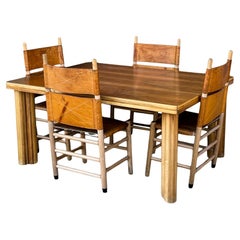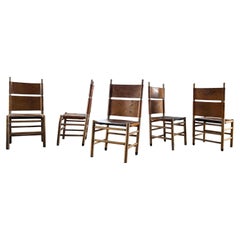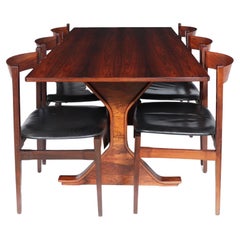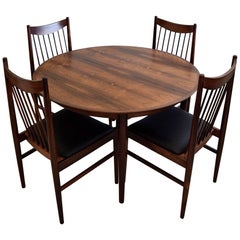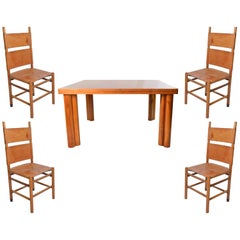Bernini Dining Room Sets
4
to
4
4
4
4
4
4
1
3
1
3
Height
to
Width
to
Depth
to
4
3
2
2
2
4
4
71
23
17
17
13
Creator: Bernini
Carlo Scarpa Walnut and Leather "Scuderia" Dining Room Set for Bernini, 1977
By Carlo Scarpa, Bernini
Located in Vicenza, IT
Scuderia dining room set, designed by Carlo Scarpa for the Italian manufacturer Bernini in 1977.
Composed of 5 mod. 783 “Kentucky” dining chairs...
Category
1970s Italian Mid-Century Modern Vintage Bernini Dining Room Sets
Materials
Leather, Plastic, Walnut
Carlo Scarpa Cognac Leather “Kentucky” Dining Chair for Bernini, 1977, Set of 5
By Carlo Scarpa, Bernini
Located in Vicenza, IT
Set of 5 mod. 783 “Kentucky” dining chairs, designed by Carlo Scarpa for the Italian manufacturer Bernini in 1977.
Structure made from oak and walnut timber.
Seats and backrest made from cognac leather.
Excellent vintage condition.
Carlo Scarpa designed this chair for the “Scuderia” series., the last project he made for Bernini.
The architect took inspiration from the “shaker” movement.
He designed the chair slightly inclined at the front. This feature allows you to swing backward (until you lean on a wall) and remain in balance.
Born in Venice on June 2nd, 1906, Carlo Scarpa began working at a very early age. A year after he had first qualified as an architect in 1926, he began working for the Murano glassmakers Cappellin & Co. in a consultative capacity. From 1927, Carlo Scarpa began to experiment with the Murano glass, and this research not only gave him excellent results here but would also inform his progress for many years to come. Between 1935 and 1937, as he entered his thirties, Carlo Scarpa accepted his first important commission, the renovation of Venice’s Cà Foscari. He adapted the spaces of this stately University building that stands on the Grand Canal banks, creating rooms for the Dean’s offices and a new hall for academic ceremonies; Mario Sironi and Mario De Luigi were charged with doing the restoration work on the frescos. After 1945, Carlo Scarpa found himself constantly busy with new commissions, including various furnishings and designs for the renovation of Venice’s Hotel Bauer and designing a tall building in Padua and a residential area in Feltre, all worth mentioning. One of his key works, despite its relatively modest diminished proportions, was the [bookshop known as the] Padiglione del Libro, which stands in Venice’s Giardini di Castello and clearly shows Scarpa’s passion for the works of Frank Lloyd Wright. In the years which were to follow, after he had met the American architect, Scarpa repeated similar experiments on other occasions, as can be seen, in particular, in the sketches he drew up in 1953 for villa Zoppas in Conegliano, which show some of his most promising work. However, this work unfortunately never came to fruition. Carlo Scarpa later created three museum layouts to prove pivotal in terms of how twentieth-century museums were set up from then on. Between 1955 and 1957, he completed extension work on Treviso’s Gipsoteca Canoviana [the museum that houses Canova’s sculptures] in Possagno, taking a similar experimental approach to the one he used for the Venezuelan Pavilion at [Venice’s] Giardini di Castello which he was building at the same time (1954-56). In Possagno Carlo Scarpa was to create one of his most significant ever works, which inevitably bears comparison with two other museum layouts that he was working on over the same period, those of:
– Galleria Nazionale di Sicilia, housed in the Palazzo Abatellis in Palermo (1953-55)
– Castelvecchio in Verona (1957- 1974), all of which were highly acclaimed, adding to his growing fame.
Two other buildings, which are beautifully arranged in spatial terms, can be added to this long list of key works that were started and, in some cases, even completed during the nineteen fifties. After winning the Olivetti award for architecture in 1956, Scarpa began work in Venice’s Piazza San Marco on an area destined to house products made by the Industrial manufacturers Ivrea. Over the same period (1959-1963), he also worked on the renovation and restoration of the gardens and ground floor of the Fondazione Querini Stampalia in Venice, which many consider one of his greatest works. While he busied himself working on-site at the Fondazione Querini Stampalia, Carlo Scarpa also began work building a villa in Udine for the Veritti family. To shed some light on the extent to which his work evolved over the years, it may perhaps be useful to compare this work with that of his very last building, villa Ottolenghi Bardolino, which was near to completion at the time of his sudden death in 1978. Upon completion of villa Veritti over the next ten years, without ever letting up on his work on renovation and layouts, Scarpa accepted some highly challenging commissions, working on the Carlo Felice Theatre in Genoa and another theatre in Vicenza.
Towards the end of this decade, in 1969, Rina Brion commissioned Carlo Scarpa to build the Brion Mausoleum in San Vito d’Altivole (Treviso), a piece he continued to work on right up until the moment of his death. Nevertheless, even though he was totally absorbed by work on this mausoleum, there are plenty of other episodes which can offer some insight into the final years of his career. As work on the San Vito d’Altivole Mausoleum began to lessen from 1973, Carlo Scarpa started building the new headquarters for the Banca Popolare di Verona. He drew up plans that were surprisingly different from the work he was carrying out at the same time on the villa Ottolenghi. However, the plans Carlo Scarpa drew up, at different times, for a monument in Brescia’s Piazza della Loggia commemorating victims of the terrorist attack on May 28th, 1974, make a sharp contrast to the work he carried out in Verona, almost as if there is a certain hesitation after so many mannered excesses. The same Pietas that informs his designs for the Piazza Della Loggia can also be seen in the presence of the water that flows through the Brion Mausoleum, almost as if to give a concrete manifestation of pity in this twentieth-century work of art. Carlo Scarpa has put together a highly sophisticated collection of structures, occupying the mausoleum’s L-shaped space stretching across both sides of the old San Vito d’Altivole cemetery. A myriad of different forms and an equally large number of different pieces, all of which are separate and yet inextricably linked to form a chain that seems to offer no promise of continuity, rising up out of these are those whose only justification for being there is to bear the warning “si vis vitam, para mortem,” [if you wish to experience life prepare for death] as if to tell a tale that suggests the circle of time, joining together the commemoration of the dead with a celebration of life. At the entrance of the Brion Mausoleum stand the “propylaea” followed by a cloister which ends by a small chapel, with an arcosolium bearing the family sarcophagi, the main pavilion, held in place on broken cast iron supports, stands over a mirror-shaped stretch of water and occupies one end of the family’s burial space. The musical sound of the walkways teamed with the luminosity of these harmoniously blended spaces shows how, in keeping with his strong sense of vision, Carlo Scarpa could make the most of all of his many skills to come up with this truly magnificent space. As well as a great commitment to architectural work, with the many projects which we have already seen punctuating his career, Carlo Scarpa also made many equally important forays into the world of applied arts. Between 1926 and 1931, he worked for the Murano glassmakers Cappellin, later taking what he had learned with him when he went to work for the glassmakers Venini from 1933 until the 1950s. The story of how he came to work on furniture design is different, however, and began with the furniture he designed to replace lost furnishings during his renovation of Cà Foscari. The later mass-produced furniture started differently, given that many pieces were originally one-off designs “made to measure.” Industrial manufacturing using these designs as prototypes came into being thanks to the continuity afforded him by Dino Gavina, who, as well as this, also invited Carlo Scarpa to become president of the company Gavina SpA, later to become SIMON, a company Gavina founded eight years on, in partnership with Maria Simoncini (whose own name accounts for the choice of company name). Carlo Scarpa and Gavina forged a strong bond in 1968 as they began to put various models of his into production for Simon, such as the “Doge” table, which also formed the basis for the “Sarpi” and “Florian” tables. In the early seventies, other tables that followed included “Valmarana,” “Quatour,” and “Orseolo.” While in 1974, they added couch and armchair “Cornaro” to the collection and the “Toledo” bed...
Category
1970s Italian Mid-Century Modern Vintage Bernini Dining Room Sets
Materials
Walnut, Leather, Plastic
Carlo Scarpa Mid-Century Brown Walnut “Scuderia” Dining Table for Bernini, 1977
By Bernini, Carlo Scarpa
Located in Vicenza, IT
“Scuderia” dining table, designed by Carlo Scarpa and produced by the Italian manufacturer Bernini in 1977.
Originally, Carlo Scarpa designed the table to restore the stable of Villa Valmarana in Vicenza in 1972.
The table features a solid walnut structure.
Available also five “Kentucky” dining...
Category
1970s Italian Mid-Century Modern Vintage Bernini Dining Room Sets
Materials
Walnut
Mid Century Italian Dining Set by Gianfranco Fratrini
By Gianfranco Frattini, Bernini
Located in Paddock Wood Tonbridge, GB
Dining table and six chairs by Gianfranco Frattini
A table and six chairs designed by Frattini and produced by Bernini in Italy in 1957. The model 552 dining table has two hourglass...
Category
1950s Italian Mid-Century Modern Vintage Bernini Dining Room Sets
Materials
Rosewood
Related Items
Arne Vodder Mid Century Modern Jatoba Dining Room Set
By Arne Vodder
Located in Weesp, NL
Stylish and elegant mid century modern Jatoba Arne Vodder dining room set.
Elegant early 1960s dining room table and chairs, model 422, designed by Arne Vodder for Sibast Denmark. Th...
Category
1960s Danish Mid-Century Modern Vintage Bernini Dining Room Sets
Materials
Wood, Leather
Set of 6 "Model 101" Dining Chairs, Designed by Gianfranco Frattini
By Cassina, Gianfranco Frattini
Located in Wolfurt, AT
This set of four chairs was designed by Guiseppe Gibelli for Fratelli Maspero and manufactured by Sormani in Italy, Mariano Comense in the 1960s. The "Elisabetta" model is made of oa...
Category
1960s Italian Mid-Century Modern Vintage Bernini Dining Room Sets
Materials
Faux Leather, Palisander
Mid-Century Mod Delfi White Marble Dining Table by Carlo Scarpa & Marcel Breuer
By Carlo Scarpa, Marcel Breuer
Located in Madrid, ES
Dining table mod. Delfi designed by Carlo Scarpa and Marcel Breuer for Gavina. Composed of two sculptural bases and a rectangular top 4 cm thick. Made in Carrara marble. Italy 1968. ...
Category
1960s Italian Mid-Century Modern Vintage Bernini Dining Room Sets
Materials
Carrara Marble
H 29.34 in W 86.62 in D 35.44 in
Mid-Century Modern Carlo Scarpa Cream Travertine Dining Table "Argo", 1970
By Carlo Scarpa
Located in Le Grand-Saconnex, CH
Mid-Century Modern oval travertine dining room table, model Argo.
Designed in 1970 by Carlo Scarpa (1906-1978) for the "Ultrarazionale" collection, produced and sold by Cattelan Ital...
Category
1970s Italian Mid-Century Modern Vintage Bernini Dining Room Sets
Materials
Travertine
H 28.35 in W 78.75 in D 47.25 in
Carlo Scarpa "Samo" Oval Table for Simon Gavina, 1971
By Carlo Scarpa, Simon Gavina Editions
Located in Lonigo, Veneto
Carlo Scarpa "Samo" oval table for Simon Gavina, white Carrara marble, Italy, 1971.
The Scarpa's way of thinking the architecture is particularly visible in this piece. The “Samo” d...
Category
1970s Italian Mid-Century Modern Vintage Bernini Dining Room Sets
Materials
Carrara Marble
Walnut 1960s Table by Silvio Coppola for Bernini
By Silvio Coppola, Bernini
Located in Varese, Lombardia
Table in solid walnut and veneer produced in the 60s by Bernini based on a design by Silvio Coppola. The table remains in general rather good condition: having not undergone any rest...
Category
1960s Italian Mid-Century Modern Vintage Bernini Dining Room Sets
Materials
Walnut
Walnut & Mohair Dining Set by Pier Luigi Colli for Fratelli Marelli, Italy, 1950
By Fratelli Marelli, Pier Luigi Colli
Located in bergen op zoom, NL
Stunning walnut dining table and six matching dining chairs by Pier Luigi Colli, handmade by the famed 'Fratelli Marelli' atelier in Cantu, Italy circa 1950.
The dining table is ...
Category
1950s Italian Mid-Century Modern Vintage Bernini Dining Room Sets
Materials
Brass
H 31.89 in W 33.86 in D 73.43 in
Carlo Scarpa 'Samo' Dining Table for Simon Gavina, Italy, 1970s
By Simon Gavina Editions, Carlo Scarpa
Located in Hellouw, NL
This Italian dining table from the 1970s exudes timeless elegance and beauty. It was designed by perhaps one of the prominent Italian modernist designers of the last century. What im...
Category
1970s Italian Mid-Century Modern Vintage Bernini Dining Room Sets
Materials
Granite
Large Travertine Pedestal "Argo" Dining Table by Carlo Scarpa for Simon/Gavina
By Carlo Scarpa, Simon Gavina Editions
Located in Danville, CA
This is the largest, single-pedestal version of this iconic design by Carlo Scarpa for Simon c. 1975. This most desirable piece is constructed of solid, beautifully figured Cream col...
Category
1970s Italian Mid-Century Modern Vintage Bernini Dining Room Sets
Materials
Travertine
H 29 in W 78.5 in D 47 in
Walnut 1960s Table by Silvio Coppola for Bernini
By Silvio Coppola, Bernini
Located in Varese, Lombardia
Table in solid walnut and veneer produced in the 60s by Bernini based on a design by Silvio Coppola. The table remains in general rather good condition: having not undergone any rest...
Category
1960s Italian Mid-Century Modern Vintage Bernini Dining Room Sets
Materials
Walnut
Valmanara Table by Carlo Scarpa for Simon International - Gavina
By Gavina, Carlo Scarpa
Located in Barcelona, ES
Valmanara table designed in 1971 by italian architect Carlo Scarpa for Simon International-Gavina. Oak wood with cerused varnish finish.
Category
1970s Italian Mid-Century Modern Vintage Bernini Dining Room Sets
Materials
Wood, Oak
De Couro of Brazil Red Leather Dining Room Set for 6, 1980s
By deCouro of Brazil
Located in Antwerp, BE
De Couro of Brasil red leather dining room set.
All in red nubuck leather;
6 dining room chairs and also the base of the dining room table.
On top a very thick rounded glass top.
...
Category
1980s Modern Vintage Bernini Dining Room Sets
Materials
Leather
Previously Available Items
Carlo Scarpa Walnut Wood Scuderia Table and Kentucky Chairs for Bernini, 1970s
By Bernini, Carlo Scarpa
Located in IT
Table: Squared walnut wood Scuderia table by Carlo Scarpa, Bernini production, 1977. Models nos. 782. Walnut and pear multilayered tabletop. Double cyli...
Category
Late 20th Century Italian Post-Modern Bernini Dining Room Sets
Materials
Leather, Walnut
H 28.35 in W 51.97 in D 51.97 in
Italian Leather and Beech Chairs and Table by Coppola for F.lli Montina, 1960s
By Bernini, Silvio Coppola
Located in MIlano, IT
Italian Leather and Beech Chairs and Table by Coppola for F.lli Montina, 1960s
Set of 6 model 330 chairs and a model 303 table by the Italian designer Silvio Coppola.
The base of the...
Category
1960s Italian Mid-Century Modern Vintage Bernini Dining Room Sets
Materials
Leather, Beech
H 31.5 in W 78.75 in D 37.41 in
Carlo Scarpa "Kentucky" Dining Chair Set, Italy, 1970s
By Bernini, Carlo Scarpa
Located in Austin, TX
"Kentucky" set of 4 chairs designed by Carlo Scarpa (father of Tobia Scarpa) for Bernini in the 1970s. Made from oak and walnut timber the chairs retain the original canvas seat and ...
Category
1970s Italian Mid-Century Modern Vintage Bernini Dining Room Sets
Materials
Canvas, Oak, Walnut
Bernini dining room sets for sale on 1stDibs.
Bernini dining room sets are available for sale on 1stDibs. These distinctive items are frequently made of wood and are designed with extraordinary care. There are many options to choose from in our collection of Bernini dining room sets, although brown editions of this piece are particularly popular. Many of the original dining room sets by Bernini were created in the mid-century modern style in italy during the 20th century. If you’re looking for additional options, many customers also consider dining room sets by Afra & Tobia Scarpa, Angelo Mangiarotti, and Maurizio Tempestini. Prices for Bernini dining room sets can differ depending upon size, time period and other attributes — on 1stDibs, these items begin at $6,329 and can go as high as $15,564, while a piece like these, on average, fetch $8,005.
